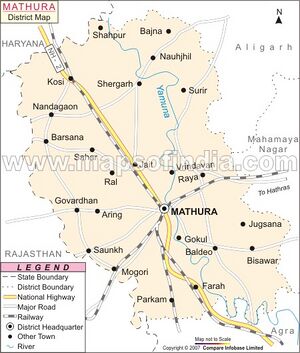Ganesara
| Author:Laxman Burdak, IFS (R) |

Ganesara (गणेशरा) is a village in Mathura tahsil of Mathura district in Uttar Pradesh.
Location
Ganeshra village is situated some three miles west of Mathura city, to the north of, the road to Govardhan.
Variants
- Ganeshara (गणेशरा) (जिला मथुरा, उ.प्र.) (AS, p.278)
- Ganesara (गणेसरा)
- Ganesra (गणेसरा)
- Gandheshvarivana (गंधेश्वरी वन)
History
Monuments
N-UP-A204: Two mounds, the second mound is known as Singer Tila at Ganesra, Mathura[1]
Ganeshra Inscription of Kshaharāta Ghaṭāka
The Journal of Royal Asiatic Society, 1912 [2] mentions....[p.120]: Under the supervision of Pandit Radha Krishna some trial excavations were carried out on various ancient sites round Mathura out of funds provided by the Government of India. These sites include 1. Mora, 2. Ganeshra, and 3. Jaisinghpura.
[p.121]: The second site examined was that of Ganeshra, a village situated some three miles west of Mathura city, to the north of, the road to Govardhan. It was here that Dr. Fuhrer discovered a very fine Bodhisattva statue, now preserved in the Lucknow Museum1, This statue, I may remark in passing, is especially interesting on account of its evident relationship to the Bodhisattva type of Gandhara.
The site of Ganeshra comprises three distinct mounds. The mound nearest the village yielded numerous red sandstone fragments, which must have belonged to a small-sized railing. One of these fragments bears an incomplete inscription in one line which I read Bhagavaprasādā. The character is Brahmi of the third or second century B.C.
Another incomplete inscription in two lines on a rounded piece of red sandstone (Pl II, Fig. 2) found in the second Ganeshra mound reads as follows
(1) . . . sa Kshaharātasa Ghaṭākasa . . . ,
(2) ... ye thupa pati . . .
Notwithstanding its very fragmentary state this short record is of interest for two reasons. First of all there can be little doubt that it records the constitution of a stūpa (Prakrit thūpa). The word following thupa may be safely restored as patiṭhāpita (पतिठापित) (Sanskrit pratishṭhāpitah प्रतिष्ठापित:). We may add that the monument in question was in all probability Buddhist. A stone parasol which was found lying at the foot of the mound, and which had previously been taken to the Museum, perhaps once surmounted the referred to in the inscription.
The second point of interest is the word Kshaharāta (क्षहरात), which occurs in the first line. This term is well known from some of the Western Cave inscriptions which mention the Kshaharata king and Satrap Nahapana. The Kshaharata clan, according to Mr. V. A. Smith,
1. It is figured in V. A. Smith, The Jain Stupa of Mathura, pl. lxxxvii ; cf. also my Mathura Catalogue, p. 39.
[p.122]: probably a branch of the Sakas, held sway in Western India in the end of the first and in the beginning of the second century of our era. It is of some interest to find a Kshaharata mentioned here in an inscription from Mathura. Unfortunately the epigraph is too fragmentary to allow our drawing any certain conclusions from it.
It may, however, be assumed that the word immediately preceding Kshaharatasa was Kshatrapasa, if we may judge from what remains of the missing letters.
The syllable ye preceding the word thupa would seem to indicate that the stupa was not founded by the Kshaharata satrap Ghaṭāka himself, but by one of his female relations. The name of Ghaṭāka does not seem to occur on coins or in any other epigraphical documents. The character of the inscription agrees closely with the Brahmi used in the records of the reign of Kanishka; it may even be earlier.
The same mound produced twenty-four inscribed bricks and brickbats. Two of them are complete (13-1/2 by 10-1/4 by 3 inches), and contain the following legend: Rōhadevasa Kōhaḍa(sa) (PI. II, Fig. 3). Portions of the same word, sometimes in reversed order, occur on several of the brickbats. On some of the broken bricks we find the name Gōmita (Sanskrit Gōmitra) or the compound Gōmitāmacha (Sanskrit Gōmitrāmātya), usually in the instrumental case, the word kāritam following (Pl II, Fig. 4). In one case we have Gōmitasa amach[ena], and in another . . . chena Kohaḍe[na], which I propose to complete as Gomitādmachena Kohadena kāritam. We may infer that Rohadeva Kohaḍa ( = Kohala ?) was the minister (amātya) of Gōmita or Gōmitra, and, as it follows that the latter was in all probability a local ruler, it is very tempting to identify him with the Gomita or Gomitra whose coins have been found at Mathura.1 The date of
1. Cf. V. A. Smith, Catalogue, pp. 190, 194.
[p.123]: the inscribed bricks must be the third or second century BC.
गणेशरा
विजयेन्द्र कुमार माथुर[3] ने लेख किया है ...गणेशरा (AS, p.278) उत्तर प्रदेश की प्रसिद्ध धार्मिक नगरी मथुरा में स्थित एक गाँव है। क्षहरात वंश के क्षत्रप घाटक का एक अभिलेख इस स्थान से वोगल (Vogel) को सन 1912 ई. में प्राप्त हुआ था, (दे. जर्नल ऑव रायल एशियाटिक सोसायटी, 1912, पृ. 121)[4] जिससे प्रथम शती ई. के लगभग मथुरा तथा निकटवर्ती प्रदेश पर शक (सिथियन) क्षत्रपों का आधिपत्य सूचित होता है।
भारतकोश[5]ने लिखा है कि इस गाँव को पहले गंधेश्वरी वन के नाम से जाना जाता था। यह स्थान ब्रजमण्डल के ऐतिहासिक स्थलों में से एक है। यह भगवान श्रीकृष्ण की दिव्य लीलाओं से सम्बंधित है। गणेशरा पहले गन्धेश्वरी तीर्थ कहलाता था- वंशी करान्निपतित: स्खलितं शिखण्डं भ्रष्टञ्च पीतवसनं व्रजराजसूनो:। यस्या: कटाक्षशरघात-विमूर्च्छितस्य तां राधिकां परिचरामि कदा रसेन।। राधिका का दूसरा नाम 'गान्धर्वा' भी है। उन्हीं के नाम के अनुसार यहाँ 'गान्धर्वा कुण्ड' आज भी श्रीराधा-कृष्ण के विलास की ध्वजा फहरा रहा है। गन्धेश्वरी का अपभ्रंश ही वर्तमान समय में 'गणेशरा' नाम से प्रसिद्ध है।...परंतु इन तथ्यों का कोई वैज्ञानिक आधार नहीं है.

